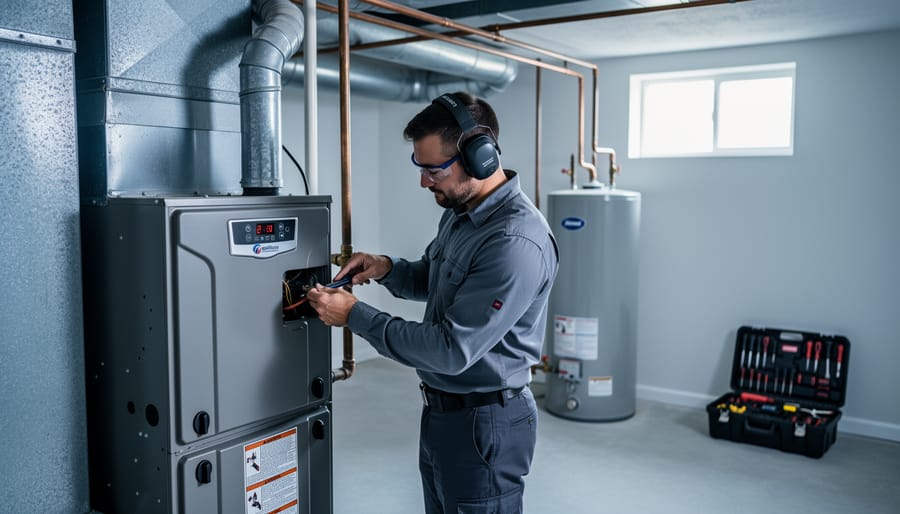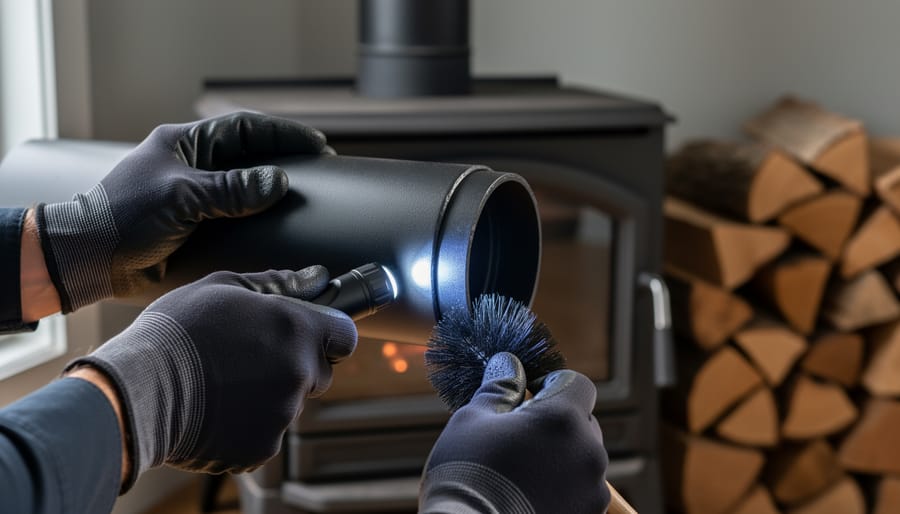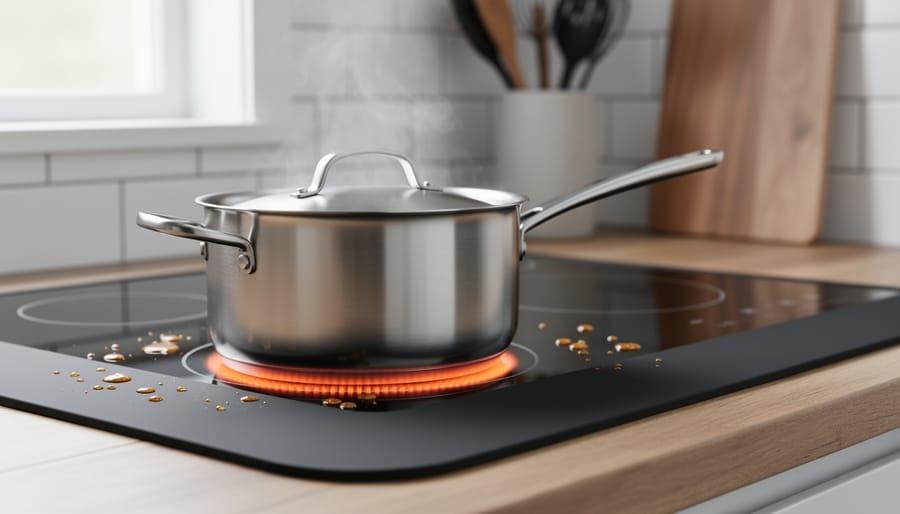Choose your fireplace surround material based on three essential factors: heat resistance for safety, maintenance requirements for long-term enjoyment, and visual harmony with your home’s character. Natural stone offers timeless elegance and exceptional durability, withstanding high temperatures while developing a rich patina over decades. Tile provides unlimited design flexibility at moderate cost, allowing you to create patterns from Mediterranean mosaics to sleek modern subway layouts. Wood mantels and surrounds deliver unmatched warmth and character but require proper clearance from the firebox—typically 6 inches minimum—and work best with gas or electric units rather than wood-burning systems.
Match your material selection to your fireplace type and heating goals. Brick and concrete excel with traditional wood-burning installations, absorbing and radiating heat long after flames die down. Metal surrounds in steel or cast iron suit contemporary spaces and pair beautifully with eco-friendly pellet stoves. Marble and granite bring luxury appeal but demand regular sealing to prevent staining from soot and ash.
Budget considerations extend beyond initial installation. While reclaimed materials and engineered stone offer cost-effective entry points, factor in cleaning frequency, repair costs, and replacement timelines. The right surround transforms your fireplace from functional appliance into a stunning focal point that enhances your home’s ambiance for years to come.
What Makes a Great Fireplace Surround Material?
Choosing the right fireplace surround material is about more than just picking something that looks good. Your surround needs to work hard, standing up to heat, daily wear, and the test of time while creating the warm, inviting atmosphere that makes a fireplace the heart of your home.
Heat resistance sits at the top of the priority list. Materials closest to the firebox face intense temperatures, so they need to handle the heat without cracking, discoloring, or releasing harmful substances. This is especially important if you’re working with a wood-burning or gas fireplace that generates significant warmth.
Durability goes hand in hand with heat resistance. A great surround material withstands not just thermal stress but also the occasional bump from fireplace tools, curious kids, or furniture rearrangements. You want something that will look beautiful years from now, not something that chips or stains at the first sign of trouble.
Maintenance requirements vary dramatically between materials. Some surrounds need regular sealing or special cleaning products, while others simply ask for an occasional wipe-down. Consider your lifestyle honestly. If you prefer low-maintenance solutions, certain materials will serve you better than others.
Design flexibility matters too. The right material should complement your home’s style, whether that’s rustic farmhouse, sleek contemporary, or timeless traditional. Some materials offer endless customization options, while others bring their own distinct character to your space.
Finally, cost plays a practical role in your decision. Beyond the initial investment, factor in installation expenses and long-term maintenance costs. Sometimes spending a bit more upfront means significant savings over time, plus the satisfaction of a surround that truly elevates your living space while supporting eco-friendly heating solutions that benefit both your home and the environment.
Stone: The Timeless Classic That Never Goes Out of Style
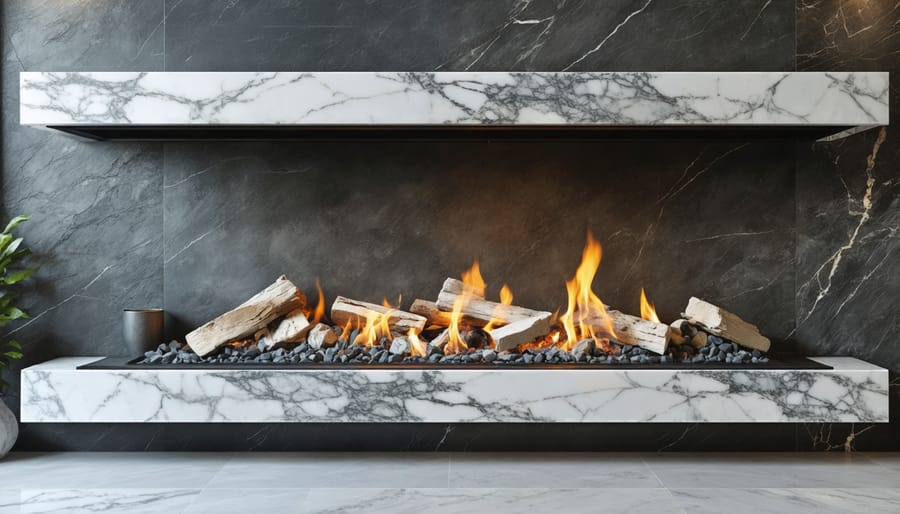
Natural vs. Manufactured Stone: What’s the Real Difference?
Choosing between natural and manufactured stone for your fireplace surround is one of those decisions that can feel overwhelming, but understanding the real differences makes it much simpler.
Natural stone comes straight from the earth—think granite, marble, slate, and limestone quarried from mountains and rock formations. Each piece is genuinely one-of-a-kind, with natural variations in color, veining, and texture that you simply can’t replicate. This uniqueness is part of its charm, though it does mean you’ll need to hand-select pieces if you’re particular about appearance. Natural stone typically carries a higher price tag, ranging from $40 to $100+ per square foot installed, and it’s incredibly durable when properly sealed and maintained.
Manufactured stone, also called engineered or cultured stone, is created by mixing crushed stone particles with resins and pigments, then molding them into consistent shapes. The technology has improved dramatically, with many products now offering surprisingly realistic appearances at roughly half the cost of natural stone. You’ll enjoy greater consistency in color and pattern, making installation planning easier.
From an environmental perspective, both have considerations. Natural stone requires quarrying and transportation but needs no manufacturing processing. Manufactured stone uses less raw material and can incorporate recycled content, though the production process does consume energy.
Durability-wise, both perform excellently around fireplaces when properly installed. Natural stone edges ahead slightly in longevity—lasting centuries versus decades—but manufactured stone resists staining better since it’s non-porous. Your choice ultimately depends on whether you prioritize authentic, timeless character or predictable appearance and budget-friendly pricing.
Wood: Warm Character with Important Safety Considerations
There’s something undeniably inviting about a wood fireplace surround. It brings warmth, texture, and timeless character that makes your hearth feel like the true heart of your home. But before you fall completely in love with that reclaimed barn wood or rich walnut mantel, let’s talk about the safety considerations that come with this classic choice.
Wood surrounds offer incredible versatility in style. Oak delivers durability with beautiful grain patterns, while maple provides a smooth surface perfect for painted finishes. Cherry and walnut bring rich, luxurious tones that deepen with age. For those seeking rustic charm, reclaimed wood adds history and environmental friendliness to your space by giving old materials new life.
Here’s the critical part: wood is combustible, which means strict clearance requirements apply. Most building codes require at least six inches of clearance between combustible materials and the firebox opening. For mantels projecting more than 1.5 inches from the wall, you’ll need additional clearance—typically one inch for every eighth inch of projection. These aren’t suggestions; they’re essential safety requirements designed to prevent house fires.
To safely incorporate wood near your fireplace, consider these approaches. Use code-compliant clearances without exception, install a non-combustible backing like cement board between the wood and wall, or opt for decorative wood elements positioned well above the firebox where heat exposure is minimal. Many homeowners successfully combine materials, using stone or tile directly around the opening with wood featured higher up as a mantel.
Maintenance involves regular dusting and occasional treatment with wood-appropriate cleaners. Check annually for signs of heat damage like discoloration, cracking, or warping, which indicate your clearances may be insufficient.
Wood surrounds create that cozy, lived-in aesthetic many homeowners crave, but respecting fire safety codes isn’t optional. When installed correctly with proper clearances, wood can safely deliver the warm, welcoming character that makes a fireplace truly feel like home.
Brick: Industrial Charm Meets Durability
Brick brings a timeless, hardworking aesthetic to any fireplace, combining industrial appeal with remarkable durability that has stood the test of time. Whether you’re drawn to the warm glow of traditional red brick or prefer a more contemporary approach, brick surrounds offer surprising versatility that works beautifully in homes ranging from cozy cottages to sleek urban lofts.
Traditional red brick creates an instant sense of warmth and nostalgia, perfect for achieving that classic hearth atmosphere. But don’t stop there. Whitewashed brick has become incredibly popular for adding a lighter, airier feel while maintaining texture and character. If you’re after something bolder, painted brick lets you customize your fireplace to match any color scheme, from dramatic charcoal to soft sage green. For renovation projects where weight or thickness is a concern, thin brick veneer delivers authentic brick appearance at a fraction of the depth and load.
From a practical standpoint, brick excels in heat performance. These solid masonry units naturally absorb, retain, and slowly radiate heat, making brick surrounds both safe and efficient. They work particularly well with wood-burning fireplaces and can enhance your environmentally friendly hearth by maximizing heat distribution.
Installation typically requires professional masonry work for traditional full brick, though thin veneer options have made DIY installation more accessible. Brick’s porous nature means sealing is recommended to prevent staining and moisture absorption, especially around active fireplaces.
Maintenance stays refreshingly simple. Regular dusting and occasional washing with mild soap keeps brick looking great. Unlike some materials, minor imperfections or soot marks often add to brick’s rustic charm rather than detracting from it. This forgiving quality makes brick an excellent choice for busy households seeking character without constant upkeep demands.

Tile: Endless Design Possibilities at Your Fingertips
Tile offers a spectacular canvas for creativity around your fireplace, transforming this functional feature into a true work of art. Whether you’re drawn to the timeless elegance of ceramic, the durability of porcelain, or the luminous beauty of glass, tile surrounds provide virtually limitless design possibilities that can complement any home aesthetic.
When selecting tile for your fireplace surround, heat resistance is your first consideration. Look for tiles rated to withstand at least 400 degrees Fahrenheit, though porcelain typically handles higher temperatures than standard ceramic. Most quality tiles work beautifully around wood-burning and gas fireplaces, but always verify the manufacturer’s heat rating before installation. Glass tiles add stunning visual interest with their reflective qualities, though they require careful selection to ensure they’re heat-resistant enough for fireplace applications.
The pattern possibilities are where tile truly shines. Create a dramatic focal point with intricate mosaic designs, establish clean lines with subway tile arrangements, or embrace bold geometry with hexagonal or arabesque patterns. Mediterranean-style homes come alive with hand-painted ceramic tiles featuring vibrant blues and yellows, while contemporary spaces benefit from sleek, large-format porcelain in neutral tones or dramatic veining that mimics natural stone.
Grout selection matters more than many homeowners realize. Darker grout colors hide soot and ash better than white, while epoxy grout offers superior stain resistance compared to standard cement-based options. The grout line width also impacts your overall aesthetic, with tight spacing creating a more seamless look and wider spacing emphasizing individual tiles.
Cost-wise, tile provides excellent value across various budgets. Basic ceramic tiles start around three to five dollars per square foot, while premium hand-painted or imported options can reach twenty-five dollars or more. Porcelain typically falls in the mid-range at six to fifteen dollars per square foot, and decorative glass tiles command premium pricing at fifteen to thirty dollars per square foot. Installation costs add another layer, generally ranging from ten to twenty dollars per square foot depending on pattern complexity.
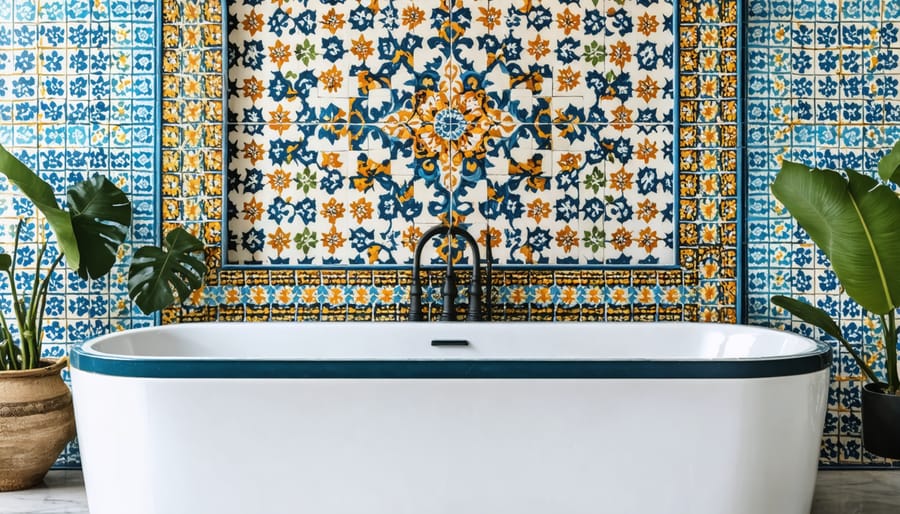
Metal: Sleek, Modern, and Surprisingly Versatile
Metal surrounds bring a sophisticated, contemporary edge to fireplace design that’s hard to match with traditional materials. If you’re drawn to clean lines and modern aesthetics, metal options like stainless steel, copper, bronze, and blackened steel might be exactly what your living space needs.
Stainless steel leads the pack for those seeking an ultra-modern look. Its reflective surface catches and bounces firelight beautifully, creating dynamic visual interest in your room. The material is incredibly durable and resists corrosion, making it a practical long-term investment. However, keep in mind that metal conducts heat efficiently, which means your surround will become quite warm during use. This isn’t necessarily a drawback, as it can actually help radiate additional warmth into your space, but you’ll want to consider this if young children or pets are part of your household.
Copper and bronze offer something truly special: they develop a natural patina over time. This living finish means your fireplace surround will evolve and gain character as the years pass. Some homeowners love this organic aging process, while others prefer to maintain the original polished appearance through regular cleaning. The choice is yours, and both approaches create stunning results.
Blackened or raw steel provides an industrial-chic vibe that pairs beautifully with exposed brick, concrete, or minimalist décor. This finish brings warmth to modern spaces without feeling cold or sterile.
Maintenance for metal surrounds is generally straightforward. Regular dusting and occasional cleaning with appropriate metal cleaners keep them looking sharp. Cost varies significantly by metal type and fabrication complexity, with stainless steel typically being more affordable than copper or custom bronze work. Metal surrounds can range from moderate to high-end pricing, but their durability and timeless appeal make them a worthwhile consideration for design-conscious homeowners.
Concrete: The Bold Statement Your Living Room Didn’t Know It Needed
Concrete is having its moment, and for good reason. This versatile material brings an unexpected sophistication to fireplace surrounds, transforming them into true focal points that command attention without overwhelming your space.
You have three main options when working with concrete: poured-in-place concrete, precast concrete panels, and decorative concrete finishes. Poured concrete offers complete customization, allowing you to create seamless, one-of-a-kind designs that flow with your room’s architecture. Precast panels provide the same industrial-chic aesthetic with easier installation and lower costs. Decorative finishes like concrete overlays can even transform existing surrounds with minimal disruption.
The beauty of concrete lies in its chameleon-like adaptability. You can leave it raw and minimalist for that warehouse loft vibe, or add pigments, textures, and acid stains to create warmer, more organic looks. Think soft grays that complement Scandinavian design, or earth-toned finishes that blend seamlessly with natural wood accents.
Practically speaking, concrete checks all the right boxes. It’s highly heat-resistant, incredibly durable, and develops a beautiful patina over time. Plus, concrete production has evolved to include eco-friendly mixes with recycled aggregates and lower carbon footprints, making it a surprisingly sustainable choice.
To soften concrete’s potentially stark appearance, pair it with warm wood mantels, plush textiles, or integrated shelving displaying personal treasures. The contrast creates visual interest while maintaining that cozy atmosphere every living room craves. Your fireplace becomes both an art installation and a lifestyle element that sparks conversation.
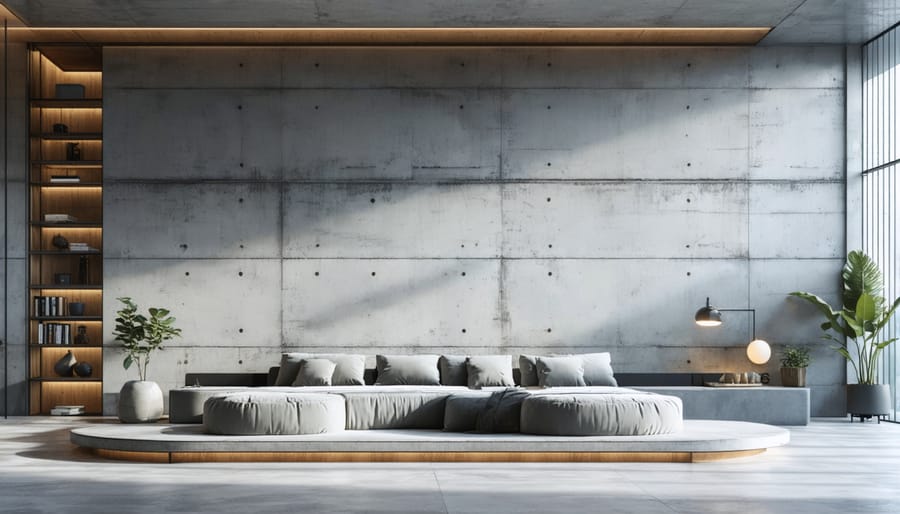
Plaster and Stucco: Mediterranean Elegance with Texture
Plaster and stucco bring an unmistakable Mediterranean warmth to your living space, transforming your fireplace into a focal point that whispers tales of sun-drenched villas and timeless craftsmanship. These materials offer remarkable versatility, allowing you to create anything from rustic Old World charm to sleek, contemporary minimalism.
Venetian plaster stands out as the premium choice, creating depth through multiple hand-applied layers that catch and reflect light beautifully. The lustrous finish develops a subtle patina over time, adding character to your fireplace surround. Standard stucco provides a more textured, artisanal appearance that works wonderfully in Spanish Colonial or Tuscan-inspired homes.
From a practical standpoint, plaster and stucco perform admirably around fireplaces. These materials tolerate moderate heat well, though you’ll want to maintain proper clearances from the firebox opening. The porous nature allows for some breathability, which can be beneficial in managing moisture. Application requires skilled craftsmanship—multiple coats are troweled on and burnished to achieve that signature look, making this a job for experienced professionals.
Maintenance proves relatively straightforward. Regular dusting and occasional gentle cleaning with a damp cloth keeps your surround looking fresh. Minor cracks can develop over time, especially in older homes with settling, but these are easily patched by a skilled plasterer.
The beauty of plaster and stucco lies in customization. Pigments can be mixed directly into the material, creating rich, earthy tones that feel organic and warm. Whether you’re dreaming of creamy whites, terracotta hues, or dramatic charcoals, these materials adapt beautifully to your vision while maintaining an eco-conscious profile through their natural composition.
What About Eco-Friendly and Sustainable Options?
Choosing environmentally friendly materials for your fireplace surround doesn’t mean compromising on beauty or durability. In fact, many sustainable fireplace materials offer unique character and superior performance while reducing your home’s environmental footprint.
Reclaimed wood options are among the most popular eco-friendly choices, bringing warmth and history to your space. Salvaged barn wood, old-growth timber from demolished buildings, or repurposed flooring creates stunning surrounds with rich patina that new wood simply can’t replicate. Just ensure any reclaimed wood is properly treated with heat-resistant, low-VOC finishes and installed with appropriate clearances from the firebox.
Recycled glass tile offers another gorgeous sustainable option. These tiles incorporate post-consumer glass into beautiful designs that catch and reflect firelight beautifully. They’re durable, heat-resistant, and available in endless colors and patterns, from subtle neutrals to bold statement pieces.
Locally sourced stone minimizes transportation emissions while supporting regional economies. Whether you choose granite, limestone, or slate from nearby quarries, you’ll reduce the carbon footprint of your project while celebrating materials native to your area. Local stone often harmonizes naturally with your home’s existing architecture too.
When selecting any material for eco-conscious fireplace design, look for low-VOC or zero-VOC adhesives, sealants, and finishes. These products protect indoor air quality without sacrificing performance or longevity.
The key to balancing sustainability with aesthetics and function is research. Ask suppliers about material sourcing, manufacturing processes, and environmental certifications. Many beautiful options exist that align with both your design vision and environmental values, proving that responsible choices enhance rather than limit your creative possibilities.
Matching Materials to Your Fireplace Type
Choosing the right surround material depends significantly on your fireplace type, as each generates different heat levels and has unique installation requirements. Let’s explore how to match materials to your specific setup.
Wood-burning fireplaces produce the highest heat output, reaching temperatures that can exceed 1,000 degrees Fahrenheit. This intense heat demands non-combustible materials like stone, brick, tile, or concrete within the immediate surround area. These traditional materials aren’t just aesthetically fitting—they’re essential for safety. Always maintain proper clearances from combustible materials, typically 6 inches or more from the firebox opening.
Gas fireplaces offer more flexibility since they generate moderate, controlled heat. While you’ll still want heat-resistant materials directly around the firebox, you can safely incorporate wood mantels and trim pieces at appropriate distances. This balance makes gas fireplaces ideal if you’re dreaming of that classic wooden mantel with stone or tile surrounding the opening itself.
Bioethanol fireplaces represent an eco-friendly heating solution with minimal heat output and no ventilation requirements. This opens up exciting possibilities for creative surrounds, including wood, metal, and even certain treated woods, though you should still verify manufacturer recommendations.
Electric fireplaces generate the least heat, giving you maximum design freedom. Nearly any material works beautifully here—from reclaimed wood to decorative metals to painted drywall. This versatility makes electric units perfect for renters or those prioritizing aesthetics and ambiance over heating capacity.
Always consult local building codes and manufacturer specifications before finalizing your material choice, ensuring both safety and optimal performance.
Choosing the perfect fireplace surround material is ultimately about finding that sweet spot where your personal style, practical needs, and safety requirements all come together harmoniously. There’s no one-size-fits-all answer here. Your ideal material depends on your lifestyle, how you use your fireplace, and what matters most to you in your home’s design.
Take time to consider the real-world factors that will affect your daily life. How much maintenance are you willing to commit to? What’s your realistic budget, including installation costs? Does your home’s style lean traditional or contemporary? And perhaps most importantly, how much heat will your fireplace generate, and which materials can safely handle that output?
If sustainability matters to you, explore eco-friendly fireplace updates that use reclaimed or responsibly sourced materials. These choices let you create a beautiful focal point while honoring your environmental values.
Before you commit to any material, consult with qualified professionals who understand local building codes and safety standards. They’ll ensure your stunning new surround isn’t just beautiful but also properly installed and completely safe for years of cozy evenings ahead.


